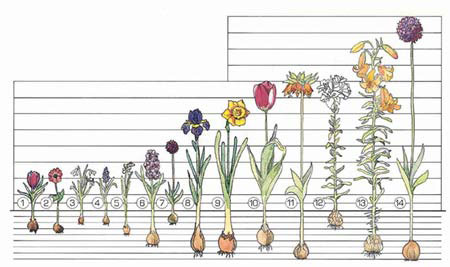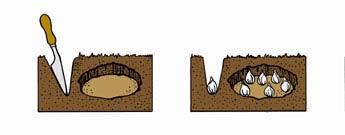Planting Bulbs
How Deep to Plant Daffodils, Tulips, & Other Bulbs
The general rule of thumb for planting spring bulbs is to plant two to three times as deep as the bulbs is tall. This means most large bulbs like tulips or daffodils will be planted about 6 inches deep while smaller bulbs will be planted 3-4 inches deep. When determining how deep to plant tulips, daffodils, and other bulbs, the depth should be measured from the surface level of the soil to the shoulder of the bulb and the eyes or crowns of the perennials. Distance between plants is measured from the center of one plant to the center of the next.

There are two basic methods of planting. One is to dig individual holes for each plant. This can be done with a garden trowel or one of the special hole-cutting tools called bulb planters. Dig the hole several inches deeper than the recommended planting depth and fill to base level with a mixture of loose soil and food for bulbs. Then place your plant in the hole and cover it with loose soil. Using your fingers, gently push the soil into position around the plant so there will be no air pockets where water can collect.
If you are planting a quantity of plants in a single area, you may want to dig an entire bed to planting depth. Then you can locate each plant just where you want it before covering with soil. Press the soil into position around each plant to eliminate air pockets.
How to Prepare the Soil for Planting Bulbs
Fall is the prime time for planting of hardy spring flowering bulbs. Bulbs and perennials need plenty of water and good drainage. If water has a tendency to stand in the planting area, you'll want to break up hard sub-soil and put in a layer of drainage material such as coarse gravel, broken stone or sifted cinders below your surface soil.
Summer-blooming Dutch bulbs and perennials are not fussy about soil - provided it is not too heavy and sticky. If soil is heavy, loosen it with lots of humus, sand, gypsum, etc. If very light, add moisture holders - humus, peat mold, etc. If you have a soil with a high clay content, it can be improved by adding compost, peat moss or some other source of organic material. The organic material should be worked in the top twelve inches of soil (eighteen inches is even better).
When to Use Fertilizer for Newly Planted Bulbs
While each plant is a complete "plant factory" in itself, with built-in nourishment, it is a good idea to mix a quantity of Breck's Food for Bulbs and Perennials with the loose soil at the bottom of your planting. This will provide additional food without any danger of "burning." Never apply fresh or half-rotted manure directly on bulbs and perennials. As soon as the shoots break through the ground in the spring, repeat the fertilizer application. Do not fertilize spring flowering bulbs after they have started flowering. This tends to encourage the development of bulb rot and sometimes shortens the life of the flowers. Summer and fall flowering bulbs should be fertilized monthly from shoot emergence until the plants reach full flower. The optimum pH range for bulbs is 6 to 7. A soil test of the planting area is necessary to determine if lime needs to be applied to adjust the soil pH. If needed, limestone should be worked into the soil. For good bud development, work Breck's Bulb and Perennials Food into the soil at planting.
Which Bulb End is Up?
One of the most frequently asked questions about planting bulbs is, "Which end goes up?" Most true bulbs, such as Tulips and Daffodils, have pointed tips which should point upward. Corms, tubers and rhizomes usually show sprouts on their upper sides, and these should be on top when planted. Some of the smaller bulbs, such as Poppy Anemones, look like small dried peas or small stones and can be planted in any direction - their shoots will find their way toward the sun.
How deep to plant tulips in the ground
Tulip bulbs are planted in the autumn before the ground freezes. By planting varieties with different bloom times, you can have tulips blooming from early to late spring. Tulips prefer a site with full or afternoon sun. In zones 7 and 8, choose a shady site or one with morning sun only, as tulips don't like a lot of heat.
How close should tulips be planted to one another?
You'll want to space bulbs 4 to 6 inches apart, so choose a large enough planting site.
How deep to plant daffodils in the ground
Planted in the fall, daffodils will bloom from early to late spring, depending on the weather conditions. Daffodils do well within hardiness zones 3 to 9. Plant bulbs at a depth of 6 inches.
Why is it important to plant daffodils deep enough?
Daffodil bulbs should be planted at the recommended depth to ensure they won't be affected by temperature variations above ground until it is the right time for them to sprout.
Have another question? Call Customer Service at 513-354-1512. Return to the Customer Service Help page or send an email directly to Customer Service .








